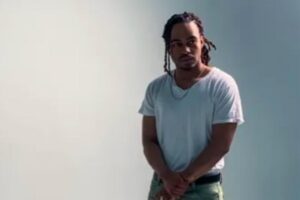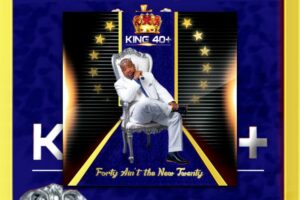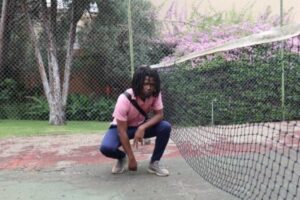
In the ever-evolving world of metal, few artists bring the same level of diversity and innovation as Jon Rhys Voerman.
Born in 1994 in Northern Ireland, Voerman has carved a unique niche for himself, merging the raw intensity of death metal with influences as varied as neo-classical music, gypsy jazz, and 80s pop. With excellent albums like “Cry Of The Witch” and “At Death’s Door,” and recent singles “Serial Killer” and “I See Blood,” Voerman continues to push boundaries and redefine the genre.
In this exclusive interview, we delve into his creative process, the inspiration behind his latest releases, and what fans can expect next from this talented musician.
Ad

Jon, it’s great to have you with us! Your music spans a variety of genres, from melodic death metal to flamenco and even 80s pop. We are thrilled to know more about your artistic journey, so let’s start from the beginning, when did you discover your passion for music and how do you manage to blend such diverse influences into your sound?
Jesus…there’s not a moment that I can remember not loving music! My Ma was an absolute rock chick, blasting Bon Jovi, Def Leppard, Motley Crue, you name it. The first album I can ever remember hearing is Rainbow’s “Stranger In Us All” and I absolutely loved it. Music was always the backbone of our house. My big sister was always introducing me to music and she played guitar for a few years when we were young. We’d put on terrible concerts for our parents doing Linkin Park and Eminem and whatnot. Kids being kids, y’know? Eventually, my sister got into heavier music and, in turn, I got into it.
I was about eleven when my sister came home with a Children of Bodom album, Hatebreeder, and it just blew me away. It was like nothing I’d ever experienced before. The fusion of these aggressive riffs that didn’t shy away from some 80s influences with these ultra melodic classical sounding melodies, it really was the first time I was ‘listening’ to music, how every instrument was complimenting the other. I started listening to more bands with that approach. By the time I was twelve, I begged my sister to teach me. So, she taught me Black Sabbath’s Iron Man, how to read tabs, and sent me off to teach myself.
Merging my influences, honestly, isn’t something I consciously do. I’ve always been a self-taught guitarist and most of my music theory I studied from a classically trained pianist who I attended music college with. So, those styles are just so ingrained in my playing. Alexi Laiho, Synyster Gates, Hizaki, Antonio Vivaldi, Mozart, Django Reinhardt…all people that have just been so essential over the years that I don’t think I’m even conscious of when I’m playing something influenced by them anymore.
“Cry Of The Witch” and “At Death’s Door” are two great albums. How do you see your musical evolution from one album to the next?
As a musician with not a lot of money and a very modest studio setup, every recording and release is an experiment. Cry of the Witch was very much an experiment in that it was my first recording with a real setup and my first experiment with making a pseudo-concept album. Of course, it’s scratchy and amateur but it still holds charm I think.
At Death’s Door is straightforward me doing what I wanted with the tools I had whether it worked or not because, at the time, it was going to be my final album. I went all out and bought Pro Tools, hired a fantastic singer so I didn’t have to throw anything away, and just went for it. Surprisingly, it got a really good reception, particularly Back To The Fire.
Your recent singles, “Serial Killer” and “I See Blood,” showcase different aspects of your musical style. Can you tell us more about the inspiration and creative process behind these tracks?
Serial Killer was, believe it or not, inspired by mid-00s rave music haha. I’m a massive fan of horror movies, even if they’re awful I’ll watch them because they’re usually so bad they’re good, and I had just got done watching a film called Superhost where the woman playing the villain was just SO MUCH FUN to watch. Like, genuinely so much fun that it kickstarted the idea of “I need to write a song called Serial Killer”. For whatever reason, I had been listening to a lot of Cascada at the time and the thumping bass is what gave me the idea for the hits in the intro. After that, it just went from there and I ended up just having so much fun with it.
I See Blood…I hate to admit it but the entire of the I See Blood EP started in November-December while I was in therapy for personal reasons. Hence why a few of the tracks deal with some heavy topics like self-harm, relapsing, and hatred. It’s very much just venting.
On a more interesting note, though, the track Witch Hunt from the EP; the lyrics for that track came from the backlash against Bambi Thug during Eurovision. Growing up in Northern Ireland and Ireland, it was just heartbreaking seeing so many people give this girl so much hate and saying she doesn’t represent them. Like, actually, some of the stuff I saw people say about her was vile. So, “Witch Hunt” is basically my way of telling those people to shut the hell up haha.
The single “Serial Killer” has a distinct 80s vibe, which is a bit of a departure from your usual death metal sound. What drew you to this style, and how did you integrate it with your usual influences?
Any fan of mine knows I never wanted to be a death metal artist. I love death metal but it can box me in at times, but I don’t have a voice to do much else and hiring singers is expensive. When I have the money for a vocalist, I feel more comfortable writing vocal parts and delving into my favourite style: 80s.
Ad

In “I See Blood,” we hear a more traditional death metal sound with powerful drumming and guttural vocals. How do you balance these heavier elements with your more melodic and eclectic influences?
I think I See Blood is a bit more traditional in a death metal sense but if you look closely there’s still a lot of the 80s, the classical, and the gypsy jazz in there. Being heavy for the sake of being heavy isn’t something I enjoy. It has to serve a purpose. Melody is something I can’t have ever leave my music. It’s just not particularly my thing.
You’ve mentioned that your influences include everything from gypsy jazz and flamenco to neo-classical and hard rock. How do you incorporate these styles into your songwriting and arrangements?
Classical definitely has a massive impact on my songwriting. In creating melodies, harmonies, and how every instrument plays off each other, I take inspiration from classical. Not all the time, but extremely often I approach composition for guitars and bass as if I am composing for strings in an orchestra. How can they complement one another best? Can I ensure both guitars aren’t just doing the same thing or will that be too messy? All things I consider as if I were writing sheet music. I get more into my other influences when composing solos and leads.
Will “Serial Killer” and “I See Blood” be part of a new album? If so, can you give us a sneak peek into what we can expect from this upcoming project?
The next project is finished other than vocals. It will be my first album entirely featuring a professional vocalist with more complex and interesting vocals, mostly clean. The most I can say at the moment is that I’m saving money to hire one of the most talented vocalists I’ve seen online and I can only hope you’re already following her work because, my God, she’s amazing.
Your music often features complex arrangements and instrumentation. Can you tell us about your songwriting process? How do you develop your compositions, and what role do different instruments play in your music?
Every instrument has its place. When I’m writing, there’s a quote from an old friend from college I live by. “Try not to have the guitars doing the same thing.”
Every song starts usually with a guitar or piano melody or a guitar riff. You’d be surprised how many of my songs started on the piano. Then it’s a case of putting it down on a click and seeing what I can come up with around it for a verse/chorus whatever. Then I usually design the drums while I’m arranging the song. Then the keys. Then bass. After all is done, I tend to spend a few days with the solo section and compose the solo, while thinking of vocals in my off time.
As a Northern Irish musician, how has your background influenced your music and the themes you explore? Are there any specific cultural or regional elements that you feel shape your sound?
I explored some cultural controversies in the first verse of the track At Death’s Door. Things I heard and dealt with growing up. Unpleasant attitudes towards certain groups of people. It’s improving…to an extent, but there’s a lot of hate.
Clubbing is very popular in Northern Ireland so there’s a lot of rave music. There’s probably some of that in my music and I like some of the rave synth sounds so I guess you could say that’s a bit of a cultural influence on my music.
You’ve worked with a variety of vocal styles, including powerful female performances on “Serial Killer.” How do you choose vocalists for your tracks, and what do they bring to your music?
I choose vocalists depending on how open-minded they are and, honestly, how much fun they are to work with. If you don’t take yourself too seriously and will as quickly jump into a Britney Spears karaoke as you would a metal karaoke, then I’m in.
Female vocalists just tend to work best with my style. There’s something about the female voice that brings my music to life far more than I think a male voice could but I’m always open to being proven wrong. For instance, I don’t think anyone else except Ren could have sung Back to the Fire.
Ad

Death metal often explores dark and intense themes. What are some of the central themes or messages you aim to convey through your music, particularly in your recent work?
I deal with a lot of the pain and hate in the world in a lot of my songs. Grand Mal deals with the epilepsy I’ve dealt with my whole life, Fucking Ugly deals with body dysmorphia, Witch Hunt deals with intolerance, Relapse With Me deals with fighting addiction, Cry Like A Bitch deals with hating domestic/sexual abuse…
Growing up, listening to songs I felt that I could relate to and I felt that expressed my hurt, my sadness, my emotions…they were an outlet. They were a way to express myself in a time I didn’t know how. I want to give people songs they can relate to and express themselves with. Holding in emotions does nothing and sometimes a song can articulate how you feel better than you yourself can.
Your artwork often complements the themes of your songs. How involved are you in the visual aspects of your projects, and how do you see them enhancing the overall experience of your music?
I try my best to let the artist have as much freedom as possible. I like to give them a basic idea of what I want but let them run wild with it. I never want to get in the way of an artist’s creativity.
Looking back at your career so far, what have been some of the most memorable moments or milestones for you as an artist?
I think my most memorable moment is winning the Autumn 2023 King’s Peak International Composition Award. It was my first full piece for strings I had written and to be acknowledged as something more than just a rocker, to be acknowledged by a board of amazing musicians from a university abroad for my composition skills…that was an amazing feeling.
What can fans expect from you in the near future? Are there any upcoming tours, collaborations, or special projects you’re excited about?
I’m currently setting up to start online tutoring to pass on my knowledge. I’m excited because as I get older and time goes by, the rockstar life looks less exciting and the prospect of going to bed at ten looks so appealing haha. But seriously, I feel like I can’t wait to get to pass on what I know and help people become the musicians they want to be.
I also am saving up money to finish my next album. While I am working with an amazing vocalist, there will be a name on there some people may recognise and I’m so excited!
Ad
Jon, it was such a pleasure having you with us today; what advice would you give to aspiring musicians who are trying to navigate the complexities of blending different genres and finding their unique sound?
It’s been such a pleasure! My best advice is to expand your horizons. Every genre has something to offer somewhere, something good or something interesting musically. I think focusing too much on rock or metal can give you tunnel vision. A lot of your influences may have influences outside Rock and Metal but to go and study those influences for yourself is to really see how to adapt them and use them in your own way.
Check the links below, discover more about Jon Rhys Voerman and his music, and remember to add his songs to your favorite playlists!
Spotify: Jon Rhys Voerman
YouTube: Jon Rhys Voerman
Instagram: Jon Rhys Voerman
LinkTree: Jon Rhys Voerman



